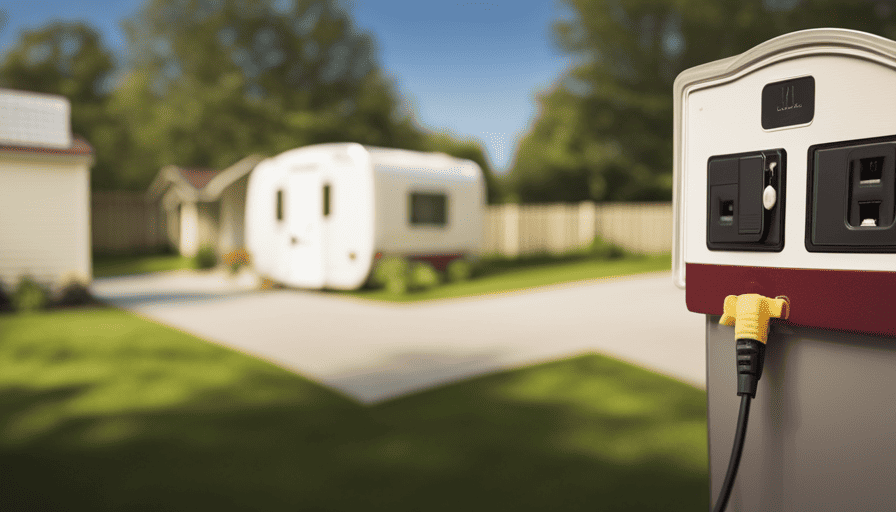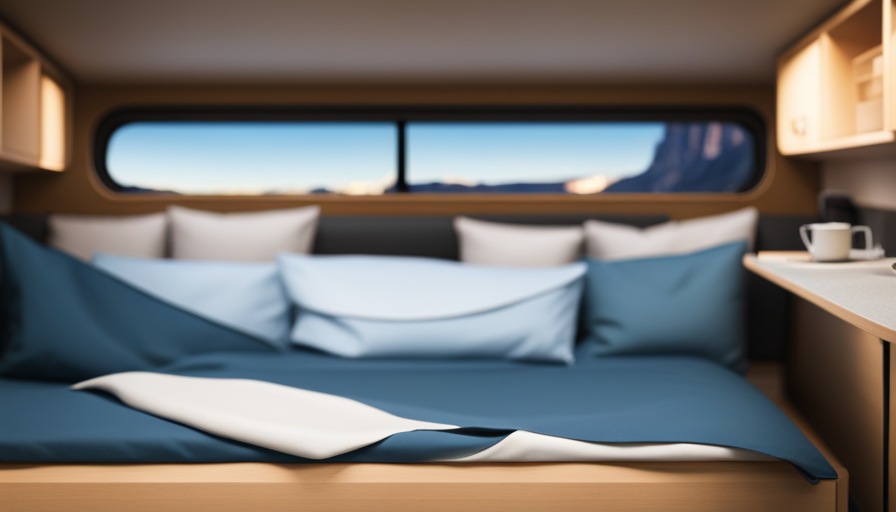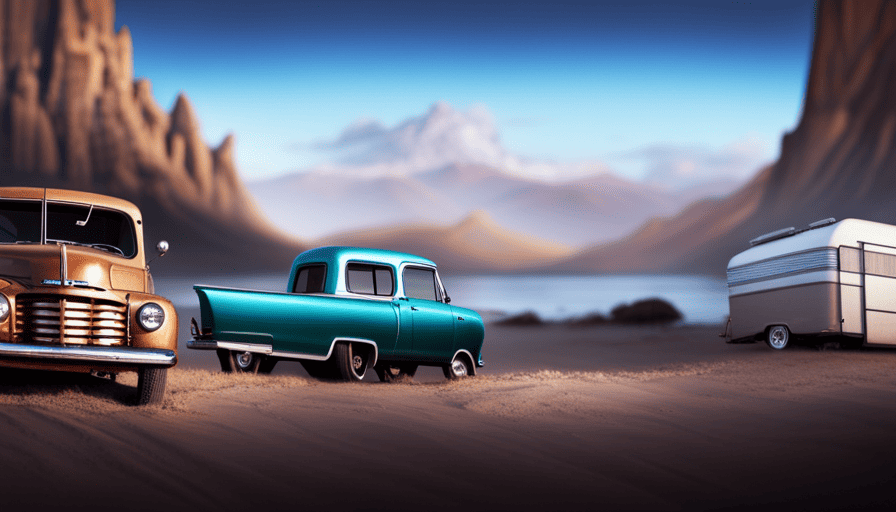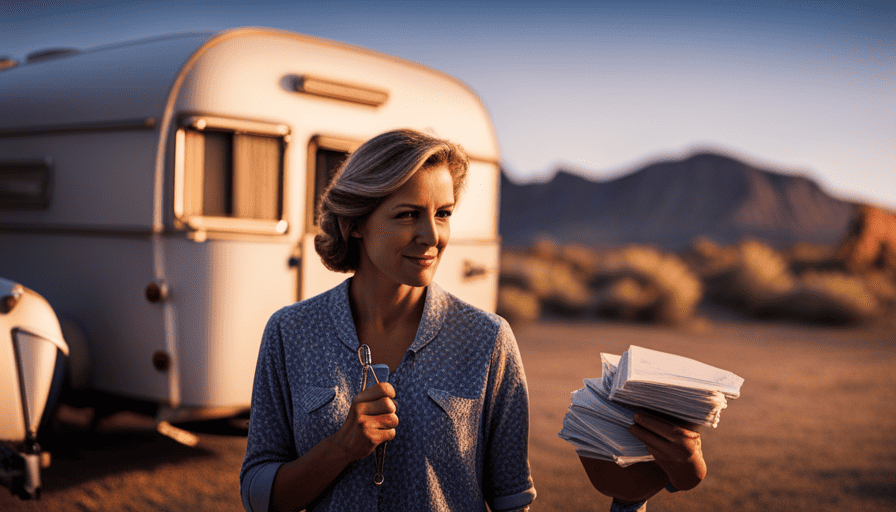Selling a camper that has a lien might seem like you’re venturing into unknown territory, but don’t worry! We’re here to serve as your reliable navigator, guiding you through the complexities of this procedure.
Selling a camper with a lien requires careful planning, diligent communication, and a thorough understanding of the steps involved. Just like a captain steering a ship through treacherous seas, we will help you navigate the murky waters of liens, paperwork, and negotiations.
In this article, we will provide you with a step-by-step guide on how to sell a camper with a lien. From understanding the lien process to transferring the title and releasing the lien, we will leave no stone unturned.
So gather your documents, calculate the payoff amount, and get ready to dive into the world of lien sales. Don’t worry, we’ll be with you every step of the way, ensuring a smooth and successful transaction.
Let’s embark on this adventure together!
Key Takeaways
- Gather all relevant documents, including title, registration, and loan documents, to understand the lien situation and prepare for the sale.
- Communicate with the lienholder to request the current payoff amount and understand any penalties or fees associated with the lien.
- Advertise and market the camper honestly and transparently, disclosing the lien situation and providing accurate information to potential buyers.
- Seek legal guidance when necessary to navigate complex lien situations, assess validity, negotiate resolution, and ensure compliance with laws.
Understand the Lien Process
So, you’re ready to sell your camper, but before you can do that, you need to understand the lien process. Selling a camper with a lien can be a bit more complicated than selling one without.
A lien is essentially a legal claim against your camper, usually held by a lender, until you pay off your debt. It’s important to comprehend the lien process to ensure a smooth and legal transaction.
One key aspect to consider is liability protection. When you sell a camper with a lien, you must take into account the lienholder’s rights. They have a stake in the transaction because they have a financial interest in your camper. This means that the lienholder has the authority to prevent the sale if the outstanding debt is not cleared. Therefore, it’s crucial to work closely with the lienholder to ensure a successful sale that satisfies their requirements.
To move forward with selling your camper, you’ll need to gather all relevant documents. This includes the title, registration, and any loan documents related to the lien. These documents will prove ownership and help facilitate the transfer of ownership to the buyer.
Now that you understand the lien process and have all the necessary documents in hand, you’re ready to move on to the next step of selling your camper.
Gather All Relevant Documents
First, make sure you have all the necessary paperwork in order to smoothly navigate the process of selling your beloved home on wheels. When it comes to selling a camper with a lien, having the right documentation is crucial. The selling process can be complex, but having all the required paperwork will help ensure a seamless transaction.
To begin, gather all relevant documents related to the lien on your camper. This includes the loan agreement, which outlines the terms and conditions of your loan, as well as any amendments or addendums.
Additionally, you will need to provide proof of insurance, registration, and title documents.
The documentation requirements may vary depending on your state and the lender, so it’s important to do thorough research or consult with a legal professional to ensure you have everything you need. Failing to provide the necessary documents can delay or even jeopardize the sale of your camper.
Once you have gathered all the required documentation, you can move on to determining the payoff amount. This is the outstanding balance on your loan that needs to be paid off before you can transfer the title to the new owner.
Determine the Payoff Amount
To accurately calculate the payoff amount, you’ll need to consult your lender and carefully review the terms and conditions of your loan agreement.
The payoff amount is the total amount you owe on the camper, including the principal balance, interest, and any applicable fees. Start by contacting your lender to request the current payoff amount. They’ll provide you with the exact figure you need to pay off the loan in full.
It’s important to communicate with the lienholder directly to ensure accuracy and avoid any misunderstandings. When speaking with the lienholder, be sure to have your loan account number and other relevant information readily available.
Additionally, carefully review your loan agreement to understand any potential penalties or fees associated with early repayment. By calculating the payoff amount and familiarizing yourself with your loan terms, you’ll be better prepared to sell your camper and communicate effectively with the lienholder. This will help ensure a smooth and successful transaction.
Communicate with the Lienholder
When you contact your lender, you’ll discover that over 50% of borrowers communicate with their lienholder directly to request the current payoff amount.
It is crucial to communicate effectively with the lienholder to ensure a smooth negotiation process. Start by gathering all the necessary information about your camper, such as the make, model, and VIN number. This will help the lienholder locate your account and provide you with the most accurate payoff amount.
Be prepared to provide proof of ownership and any relevant documentation, such as the loan agreement or title. Clearly explain your intention to sell the camper and inquire about any specific requirements or procedures the lienholder may have.
It’s important to maintain a professional and cooperative tone throughout the conversation. Take note of any important information or instructions given by the lienholder and follow up promptly.
Once you’ve obtained the payoff amount, you can move on to the next step in the process: advertising and marketing your camper to potential buyers.
Advertise and Market Your Camper
Ready to get your camper noticed? Let’s dive into some creative ways to showcase your mobile oasis and attract potential buyers!
When it comes to advertising and marketing your camper with a lien, online platforms and social media marketing are your best friends. Start by creating a compelling listing on popular online platforms such as Craigslist, RV Trader, or Facebook Marketplace. Include high-quality photos that highlight the best features of your camper, and write a detailed description that emphasizes its unique qualities.
Additionally, harness the power of social media to reach a wider audience. Share your listing on your personal social media accounts and ask friends and family to help spread the word. Join RV and camping enthusiast groups on platforms like Facebook and Instagram, where you can connect with individuals who are actively looking to purchase a camper.
Remember, honesty and transparency are crucial when dealing with potential buyers. In the next section, we will discuss how to effectively communicate the lien situation and be upfront about any issues or concerns.
Selling a camper with a lien can be challenging, but with the right marketing strategies and open communication, you can attract interested buyers who understand the process.
Be Honest and Transparent with Potential Buyers
Be upfront and transparent with potential buyers about the situation with your camper’s lien, so they know exactly what they’re getting into and can make an informed decision. Building trust is crucial when selling a camper with a lien. Disclosing all relevant information about the lien will help establish trust and credibility with potential buyers.
Provide them with details such as the amount owed, the lienholder’s contact information, and any possible implications or restrictions associated with the lien.
When discussing the lien, it’s important to remain professional, analytical, and detail-oriented. Clearly explain the reasons for the lien and how it affects the ownership transfer process. Answer any questions potential buyers may have and address their concerns honestly. By providing accurate and complete information, you demonstrate your commitment to transparency and help potential buyers feel more comfortable about the transaction.
In addition to disclosing information, emphasize the steps you’ve taken to resolve the lien. If you have a repayment plan in place or have initiated negotiations with the lienholder, make sure to communicate this to potential buyers. This will show that you’re actively working towards resolving the situation and can help alleviate any concerns they may have.
Next, we’ll discuss how to negotiate the sale price, taking into account the lien and its impact on the value of your camper.
Negotiate the Sale Price
Let’s dive into how we can haggle over the price when considering the impact of the lien on the value of our recreational vehicle. Negotiating the sale price of a camper with a lien can be a delicate process, but with the right negotiation tactics and pricing strategies, we can maximize our chances of getting a fair deal.
Firstly, it’s important to do our research and determine the market value of our camper. This will give us a baseline to work from during negotiations. It’s also crucial to consider the impact of the lien on the value of the camper. Potential buyers will be hesitant to pay the full asking price if they know there is an outstanding lien. Therefore, we should be prepared to adjust our price accordingly.
During negotiations, we can use various tactics to justify our asking price. Highlighting the positive aspects of the camper, such as its condition, features, and any recent upgrades, can help us justify a higher price. Additionally, we can emphasize the potential cost savings for the buyer, such as if the lien is close to being paid off or if we’re willing to assist with lien resolution.
Negotiating the sale price of a camper with a lien requires careful consideration of market value and the impact of the lien. By employing effective negotiation tactics and pricing strategies, we can increase our chances of achieving a satisfactory outcome.
Now, let’s move on to the next step and discuss how to complete the sale transaction.
Complete the Sale Transaction
After successfully negotiating the sale price, it’s time to move forward and complete the sale transaction. This step requires careful attention to detail and a strategic approach to ensure a smooth and seamless transaction.
One of the key aspects of completing the sale transaction is to implement effective negotiating strategies to handle any objections that may arise. Buyers may have concerns about the lien on the camper, and it’s crucial to address these concerns in a professional and reassuring manner. By providing clear and concise information about the lien, its status, and any necessary steps to transfer the title, you can help alleviate any concerns the buyer may have.
It’s important to be prepared for objections and have all the necessary documentation readily available. This includes the lien release documents, bill of sale, and any other relevant paperwork. By having these documents organized and easily accessible, you can save time and avoid any potential delays in the sale process.
As we move forward to the next step of transferring the title and releasing the lien, it’s important to ensure that all parties involved are well-informed and fully understand the process. By maintaining open lines of communication and providing clear instructions, we can ensure a smooth transition to the final stage of selling a camper with a lien.
Transfer the Title and Release the Lien
To successfully transfer ownership and resolve any outstanding financial claims, we must now proceed with the formalities of transferring the title and releasing the lien.
Understanding liens is crucial in this process. A lien is a legal claim by a creditor on a property, in this case, your camper, until the debt is paid off. As the seller, you need to communicate with the lienholder to ensure a smooth transfer.
First, contact the lienholder and inform them about the pending sale. They will guide you through the necessary steps to release the lien. Provide them with the buyer’s information and any required documentation they may need.
Next, work with the lienholder to complete the necessary paperwork to transfer the title. This may include a lien release form or a release of interest form. Ensure that all parties sign the required documents and that they are properly notarized.
Once the lienholder has released the lien, you can transfer the title to the buyer. This typically involves signing the title over to the new owner and submitting it to the appropriate local agency, such as the Department of Motor Vehicles.
Understanding liens and effectively communicating with the lienholder are essential steps in transferring the title and releasing the lien on your camper. Seek legal guidance if needed to navigate this process smoothly and ensure all legal requirements are met.
Seek Legal Guidance if Needed
To successfully sell a camper with a lien, it’s crucial to navigate the process of transferring the title and releasing the lien. However, in some cases, this process can become complex and require legal guidance. Seeking legal advice can provide valuable insight and expertise to help resolve any issues related to the lien.
When faced with a challenging lien situation, consulting with a legal professional can help clarify your rights and options. They can guide you through the necessary steps to resolve the lien and ensure a smooth transaction.
Here are three ways legal guidance can assist you in resolving a lien:
-
Assessing the lien validity: A legal expert can review the lien documentation and determine if it’s valid and enforceable. This assessment is crucial to understanding your obligations and rights as you proceed with the sale.
-
Negotiating lien resolution: If the lien is determined to be valid, a lawyer can negotiate with the lienholder on your behalf. They can work towards a resolution that satisfies all parties involved and allows for the transfer of ownership.
-
Providing legal protection: Legal guidance ensures that you’re protected throughout the process. They can draft necessary legal documents, review contracts, and ensure compliance with all applicable laws.
Navigating the complexities of selling a camper with a lien can be challenging. Seeking legal advice can provide the expertise needed to resolve any lien-related issues and help you successfully complete the sale.
Frequently Asked Questions
What is a lien and how does it affect the selling process of a camper?
A lien is a legal claim on a property, including a camper, that serves as security for a debt or obligation. The presence of a lien can complicate the selling process as it must be removed before transferring ownership.
The lien removal process can involve contacting the lienholder, settling the outstanding debt, and obtaining a lien release document. The impact of a lien on a camper’s resale value can be significant, as potential buyers may be hesitant to purchase a vehicle with a lien due to potential legal complications.
Can I sell my camper if there is still a lien on it?
Yes, it’s possible to sell a camper even if there’s still a lien on it. However, it involves a more complex process compared to selling a camper without a lien. Selling a camper with a lien requires obtaining a payoff amount from the lien holder, paying off the lien, and then transferring the title to the new owner.
It’s crucial to follow the necessary steps and ensure all legal obligations are met to successfully complete the selling process of a camper with a lien.
How do I find out the payoff amount for my camper’s lien?
To find out the payoff amount for my camper’s lien, we can contact the lienholder directly. They’ll have the most accurate information regarding the outstanding balance on the loan. Lienholder communication methods may include calling their customer service hotline or visiting their website.
It’s important to provide them with your loan account number or any other identifying information they may require. This’ll allow them to provide you with the precise payoff amount for your camper’s lien.
What should I do if the lienholder is unresponsive or difficult to communicate with?
Dealing with unresponsive lienholders can be frustrating, but there are alternative solutions to selling with a lien. When faced with a difficult or uncommunicative lienholder, it’s important to remain patient and persistent.
Start by documenting all attempts at communication and keep a record of any correspondence. If direct communication fails, consider reaching out to a lawyer or a third-party mediator who can help navigate the situation.
Exploring alternative options such as refinancing or negotiating a settlement may also be worth considering.
Are there any legal implications or risks involved in selling a camper with a lien?
Legal consequences and potential buyer concerns must be carefully considered when selling a camper with a lien. The presence of a lien means that the camper is collateral for a debt, and the lienholder has a legal right to the vehicle until the debt is fully paid.
Selling a camper with a lien involves transferring this legal right to the potential buyer, who may be hesitant to take on a vehicle with an outstanding debt. Additionally, failure to properly handle the lien during the sale can result in legal complications for both the seller and the buyer.
What Should I Do If I Want to Sell a Camper That Has a Lien on it?
If you find yourself in a situation where you want to sell a camper that has a lien on it, there are a few steps you need to take. First, contact your lien holder to discuss the situation and get clarity on the outstanding balance. Once you have a clear understanding, you can list the camper for sale, informing potential buyers about the lien. During the selling process, ensure transparency and provide all necessary information to potential buyers. By following these steps, you can navigate the process of selling your camper smoothly, even with a lien on it.
Conclusion
In conclusion, selling a camper with a lien can be a complex process, but with careful planning and attention to detail, it can be successfully navigated.
By understanding the lien process, gathering all necessary documents, and communicating effectively with the lienholder, you can ensure a smooth transaction.
Taking the time to advertise and market your camper, negotiate a fair sale price, and complete the necessary paperwork will help you release the lien and transfer the title to the new owner.
Remember, seeking legal guidance if needed is always a wise decision. Happy selling!










